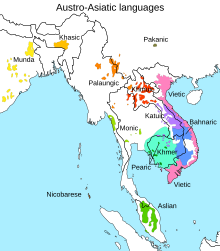| Khmer | |
|---|---|
| Cambodian | |
| ភាសាខ្មែរ
/ ខេមរភាសា Phéasa Khmêr / Khémôrôphéasa | |
 Phéasa Khmêr "Khmer language" written in Khmer script | |
| Pronunciation | [pʰiəsaː kʰmae] [kʰeːmarapʰiəsaː] |
| Native to | |
| Ethnicity | Khmer |
| speakers | L1: 17 million (2019)[1] L2: 1 million (no date)[1] |
Austroasiatic
| |
Early forms | |
| Official status | |
Official language in | |
Recognised minority language in | |
| Regulated by | Royal Academy of Cambodia, National Council of Khmer Language[2] |
| Language codes | |
| ISO 639-1 | km Central Khmer |
| ISO 639-2 | khm Central Khmer |
| ISO 639-3 | Either:khm – Khmerkxm – Northern Khmer |
| Glottolog | khme1253 Khmericcent1989 Central Khmer |
| Linguasphere | 46-FBA-a |
 Khmer | |
Khmer (/kəˈmɛər/ kə-MAIR;[3] ខ្មែរ, UNGEGN: Khmêr [kʰmae]) is an Austroasiatic language spoken natively by the Khmer people. This language is an official language and national language of Cambodia. The language is also widely spoken by Khmer people in Eastern Thailand and Isan, Thailand, also in Southeast and Mekong Delta of Vietnam.
Khmer has been influenced considerably by Sanskrit and Pali especially in the royal and religious registers, through Hinduism and Buddhism,[4] due to Old Khmer being the language of the historical empires of Chenla and Angkor.
The vast majority of Khmer speakers speak Central Khmer, the dialect of the central plain where the Khmer are most heavily concentrated. Within Cambodia, regional accents exist in remote areas but these are regarded as varieties of Central Khmer. Two exceptions are the speech of the capital, Phnom Penh, and that of the Khmer Khe in Stung Treng province, both of which differ sufficiently enough from Central Khmer to be considered separate dialects of Khmer.
Outside of Cambodia, three distinct dialects are spoken by ethnic Khmers native to areas that were historically part of the Khmer Empire. The Northern Khmer dialect is spoken by over a million Khmers in the southern regions of Northeast Thailand and is treated by some linguists as a separate language. Khmer Krom, or Southern Khmer, is the first language of the Khmer of Vietnam, while the Khmer living in the remote Cardamom Mountains speak a very conservative dialect that still displays features of the Middle Khmer language.
Khmer is primarily an analytic, isolating language. There are no inflections, conjugations or case endings. Instead, particles and auxiliary words are used to indicate grammatical relationships. General word order is subject–verb–object, and modifiers follow the word they modify. Classifiers appear after numbers when used to count nouns, though not always so consistently as in languages like Chinese. In spoken Khmer, topic-comment structure is common, and the perceived social relation between participants determines which sets of vocabulary, such as pronouns and honorifics, are proper.
Khmer differs from neighboring languages such as Burmese, Thai, Lao, and Vietnamese in that it is not a tonal language. Words are stressed on the final syllable, hence many words conform to the typical Mon–Khmer pattern of a stressed syllable preceded by a minor syllable. The language has been written in the Khmer script, an abugida descended from the Brahmi script via the southern Indian Pallava script, since at least the 7th century. The script's form and use has evolved over the centuries; its modern features include subscripted versions of consonants used to write clusters and a division of consonants into two series with different inherent vowels.
- ^ a b Khmer at Ethnologue (27th ed., 2024)

Northern Khmer at Ethnologue (27th ed., 2024)
- ^ "National Council of Khmer Language". nckl.rac.gov.kh. Retrieved 12 April 2024.
- ^ Laurie Bauer, 2007, The Linguistics Student's Handbook, Edinburgh
- ^ Smyth, David A; Jacob, Judith Margaret (1993). Cambodian Linguistics, Literature and History: Collected Articles. Routledge. ISBN 978-0-728-60218-2.